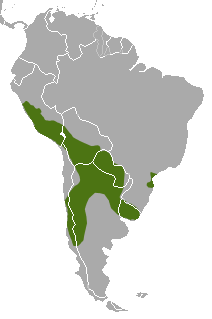| Molina's hog-nosed skunk | |
|---|---|
 | |
| Scientific classification | |
| Kingdom: | Animalia |
| Phylum: | Chordata |
| Class: | Mammalia |
| Order: | Carnivora |
| Family: | Mephitidae |
| Genus: | Conepatus |
| Species: | C. chinga |
| Binomial name | |
| Conepatus chinga (Molina, 1782) | |
 | |
| Molina's hog-nosed skunk range | |
Molina's hog-nosed skunk, also called the Andes skunk (Conepatus chinga), is a skunk species from South America. It is found in Argentina, Bolivia, Brazil, Chile, Peru, Paraguay, and Uruguay, at elevations up to 5000 m.
